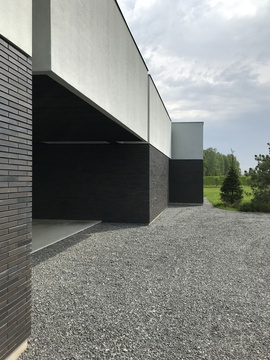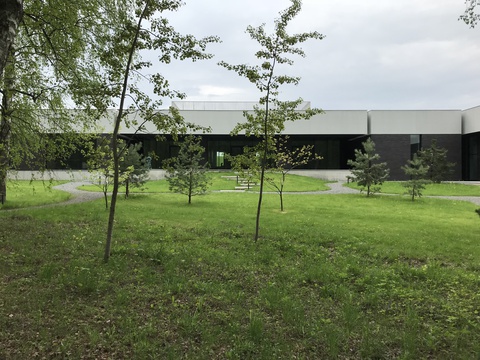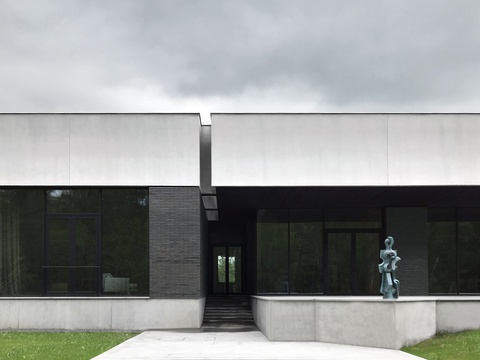
Villa Zero
Type – Country house
Location – Moscow region, Russia
Year – 2013-2019
Villa Zero is a country house complex, consisting of the entrance, main house, guest house with a sauna, a summer pavilion, and small bridges in the pond area, all of which, together with the site’s unique nature and landscape solutions, create a single ensemble. The elongated volume of the one-story entrance house screens the villa from the roadway. It is divided into two parts by a driveway through the center, linked by a massive pergola. The smaller part provides accommodation for the staff, while the larger part houses technical and utility rooms. The façades features three tiers: the brick walls are sandwiched between two horizontal floor and ceiling slabs.
From the entrance house stretches an avenue of willows, smoothly curving around an artificial hill; beyond it emerges the initially concealed volume of the main house. On the other side of the willow allée rises a second, smaller hill. This part of the villa is dedicated to agriculture (sacra agricultura), with vast fruit orchards sprawled on the gently-sloping southern side of the hill. On the steep northern slope of the bigger hill starts the gentle descent to the forest, which is where the volume of the main house is located.
The building consists of two horizontal elements–the lower slab of the foundation with multiple split levels following existing, natural slopes, and the upper roof slab which, in contrast with the former, remains level throughout the structure. As a result, the inner space varies in height. As you enter the low-height space of the main entrance and descend the steps, you find yourself in an enfilade of high spaces looking onto the forest, with access to open terraces located on the lower foundation slab.
Thick brick walls and columns rest upon the lower slab, laid over the ground, and carry the upper slab, whose façades are accentuated by a tall, smooth frieze.
The structure of the house consists of three zones of different functions, connected by passageways, looking onto the forest. This three-part structure is can be felt when you are inside the house, thanks to the use of exterior brick in the interior of the home.
Natural lime coating with organic pigments, oak board panels, and panels upholstered in natural felt or linen were used for the finishing of the walls.
Oak boards, tiles and steps made of lime and marble were chosen for flooring. Tall wooden door frames, just like the skirting boards, are flush with the surface of the walls and feature steel profiles.
The house is next to a thick forest, which can be accessed by a gravel path from the terraces. These narrow, winding paths, in line with the natural contours of the site, lead you to the picturesque pond and guest house with a sauna, which seemingly hover in mid-air. Light pedestrian bridges, built across natural brooks flowing into the pond, merge with the surrounding nature.
The “Belvedere"—a triangular, wooden pavilion—rises organically out of the trees and shrubs on the other side of the pond.
All the structures in the forest part of the property are built from timber and painted black, responding like a tuning fork to the ever-changing colors of the surrounding nature.
From the entrance house stretches an avenue of willows, smoothly curving around an artificial hill; beyond it emerges the initially concealed volume of the main house. On the other side of the willow allée rises a second, smaller hill. This part of the villa is dedicated to agriculture (sacra agricultura), with vast fruit orchards sprawled on the gently-sloping southern side of the hill. On the steep northern slope of the bigger hill starts the gentle descent to the forest, which is where the volume of the main house is located.
The building consists of two horizontal elements–the lower slab of the foundation with multiple split levels following existing, natural slopes, and the upper roof slab which, in contrast with the former, remains level throughout the structure. As a result, the inner space varies in height. As you enter the low-height space of the main entrance and descend the steps, you find yourself in an enfilade of high spaces looking onto the forest, with access to open terraces located on the lower foundation slab.
Thick brick walls and columns rest upon the lower slab, laid over the ground, and carry the upper slab, whose façades are accentuated by a tall, smooth frieze.
The structure of the house consists of three zones of different functions, connected by passageways, looking onto the forest. This three-part structure is can be felt when you are inside the house, thanks to the use of exterior brick in the interior of the home.
Natural lime coating with organic pigments, oak board panels, and panels upholstered in natural felt or linen were used for the finishing of the walls.
Oak boards, tiles and steps made of lime and marble were chosen for flooring. Tall wooden door frames, just like the skirting boards, are flush with the surface of the walls and feature steel profiles.
The house is next to a thick forest, which can be accessed by a gravel path from the terraces. These narrow, winding paths, in line with the natural contours of the site, lead you to the picturesque pond and guest house with a sauna, which seemingly hover in mid-air. Light pedestrian bridges, built across natural brooks flowing into the pond, merge with the surrounding nature.
The “Belvedere"—a triangular, wooden pavilion—rises organically out of the trees and shrubs on the other side of the pond.
All the structures in the forest part of the property are built from timber and painted black, responding like a tuning fork to the ever-changing colors of the surrounding nature.









